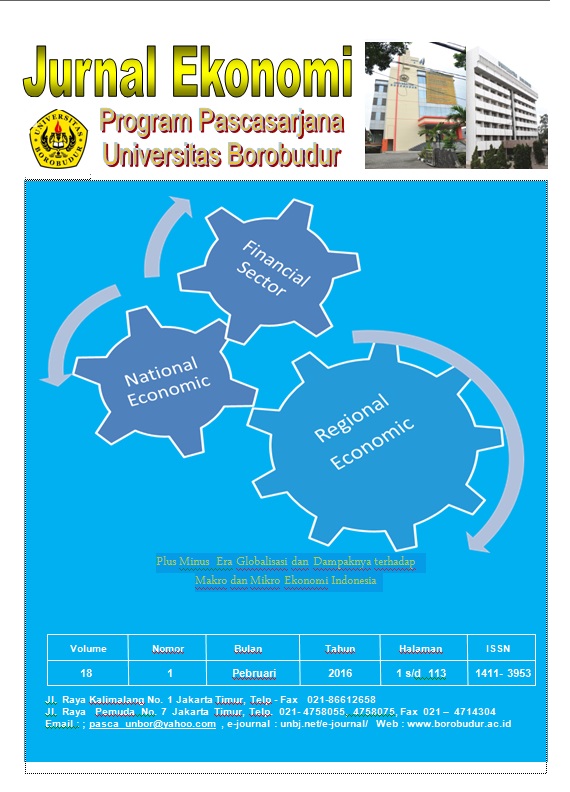Hubungan Kulaitas Pelayanan dan Kepuasan Pelanggan Dalam Pembentukan Intensi Pembelian Konsumen Matahari Group di DKI Jakarta
DOI:
https://doi.org/10.37721/je.v18i1.289Abstract
The research aimed to test relationship service quality and customer satisfaction, and interaction between service quality and customer satisfaction in establishment of customer’s purchasing intention. The research was conducted at department store managed by Matahari Group in DKI Jakarta. Samples were determined by convenience sampling method and purposive sampling method with respondents that numbered 140 persons. Gathering data was done by way of giving customers the question list that contained about service quality, customer satisfaction and customer's purchasing intention. Analysis method in this research used Analysis Regression Moderator based on model that was instituted by Taylor and Baker (1994). The results of this research shown the existence of significant association between service quality and customer satisfaction, and interactions among service quality and customer satisfaction toward customer’s purchasing intention. Interaction between service quality and customer satisfaction explains rather the variance of purchasing intention than each variable. It is shown by R2 resulted that is as big as 78.8%.References
Aiken, L. dan S.G West (1991), Multiple
Regression: Testing and Interpreting
Interaction, London: Sage.
Azwar, S. (1997), Reliabilitas dan Validitas,
Yogyakarta: Pustaka Pelajar.
Babbie, E. (1995), The Practice of Social
Research, 7th
ed, Belmout:
Wadsworth Publishing Company.
Bitner, M.J. (1990), “Evaluating Service
Encounters: The Effecs of Physical
Surrounding and Employee
Responses,” Journal of Marketing,
No. 55, April, p. 69-82.
Bolton, R.D. dan J.H. Drew (1991), “A
Longitudinal Analysis of The Impact
of Service Change on Customer
Antitudes,” Journal of Marketing,
No. 55, Januari, p. 1-9.
Cooper, D.R. dan C.W. Emory (1995),
Business Research Methods, 5th
ed,
Chicago: Richard D. Irwin Inc.
Cronin, J.J. dan S.A. Taylor (1992),
“Measuring Service Quality: A
Reexamination and Extension,”
Journal of Marketing, July, p. 55 - 68.
Dabholkar, P.A., D.I. Thoipe dan J.O. Rentz
(1996), “A Measure of Service
Quality For Retail Stores : Scale
Development and Validation,”
Journal of The Academy Marketing
Science, Vol. 24, No. l,p.3-16.
Fitzsimmons, J.A dan M.J. Fitzimmons
(1994), Service Management For
Competitive Advantage, New York:
Mc. Graw-Hill Inc.
Hadi, S. (1987), Metodologi Research, Jilid I,
Yogyakarta: Yayasan Penerbit
Fakultas Psikologi UGM.
Huck, S.W. danCormier, W.H. (1996),
Reading Statistics and Research, 2th
ed., New York: Helper Collins
Publisher Inc.
Kotler, P. (1997), Marketing Management:
Analysis, Planning. Implementation
and Control, 9th
ed, Upper Saddle
River, New Jersey: Prentice Hall Inc.
Madu, N.C., C.H. Kueh dan Jacob (1996),
“An Empirical Assesment of The
Influence of Quality Dimensions on
Organizational Performance,”
International Production Research,
Vol. 34, No. 7, p. 1943-1962.
Mantra, I.E. dan Kasto (1989), “Penentuan
Sampel,” M. Singarimbun dan S.
Effendi (ed.), Metode Penelitian
Survai, Yogyakarta: LP3ES.
Naumann, E., dan K. Giel (1995), Customer
Satisfaction Measurement and
Management, Cincinnati, Ohio:
Thompson Executive Press.
Parasuraman, A., V.a. Ziethaml, danL.L.
Berry (1985), “A Conceptual Model
of Service Quality and Implication
For Future Research,” Journal of
Marketing, Vol. 49, p. 41 - 50.
___________, (1988), SERVQUAL: A
Multiple – Item Scale For Measuring
Consumer Perceptions of Service
Quality,” Journal of Retailing, 46(1),
p. 12-14.
Sekaran, U. (1992), Research Methods For
Measuring Consumer Perceptions of
Service Quality,” Journal of
Retailing, 46(1), p. 12 - 14.

